NVIDIA's GeForce GTX 550 Ti: Coming Up Short At $150
by Ryan Smith on March 15, 2011 9:00 AM ESTPower, Temperature, & Noise
Last but not least as always is our look at the power consumption, temperatures, and acoustics of the GTX 550 Ti. As a result NVIDIA’s tinkering with both power efficiency and clocks, performance has gone way up but power has also gone up too: the official TDP has gone up by 10W.
Please note that as we don’t have a true reference card our testing methodology has been slightly tweaked. We’ve tested the AMP at both GTX 550 Ti reference clocks and at its factory overclock for all metrics, however noise and temperature in particular are going to significantly vary from manufacturer to manufacturer.
| GeForce GTS 450 & GTX 550 Voltage | ||||
| GTS 450 | Zotac GTX 550 Ti Amp | Idle | ||
| 1.05v | 1.1525v | 0.95v | ||
The load voltage on our Zotac AMP is 1.1525v, which compared to GF106/GTS 450 ends up being quite high. No doubt Zotac has given the card some more voltage to handle the factory overclock, however this will also skew our power results for load. Idle however remains unchanged at 0.95v.
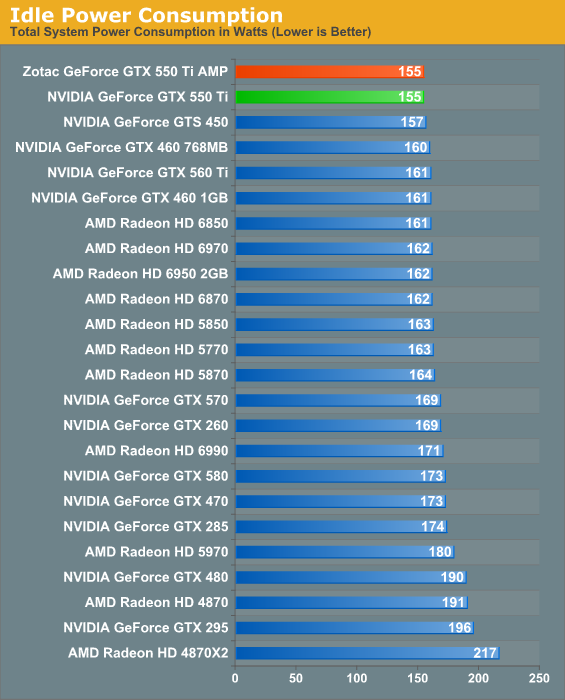
Right off the bat, idle power consumption looks good. At 155W the Zotac GTX 550 AMP beats even the reference GTS 450 by 2W, and the gap with the Radeons is much larger. Here we’re looking at a 6W advantage over the 6850, and 8W over the 5770. This is no small feat given how hard it is to reduce idle power usage, and showcases the benefits of NVIDIA’s transistor tinkering.
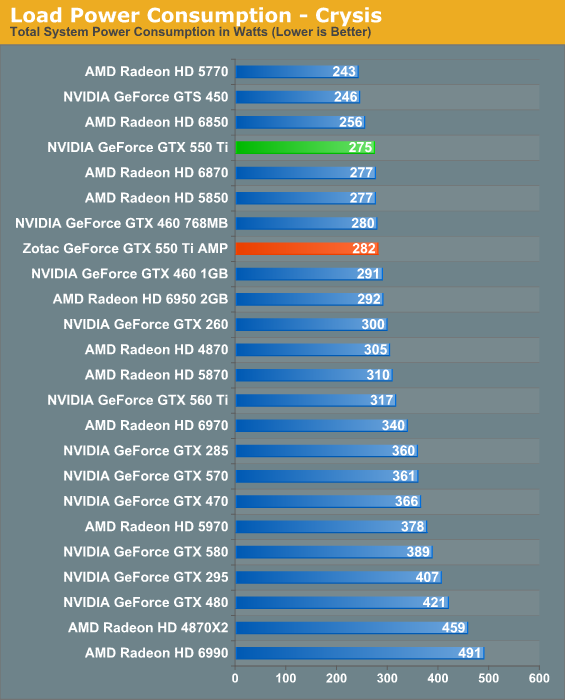
Power consumption leaves much to be desired however, and it’s at this point that we can’t easily separate the GTX 550 Ti from the Zotac GTX 550 AMP. If the Zotac card did not have an overclock, perhaps it would have a lower load voltage, and as such lower power draw under load. But in this case it does not, which leads to a total system power draw difference of 19W over the 6850, never mind the 5770.
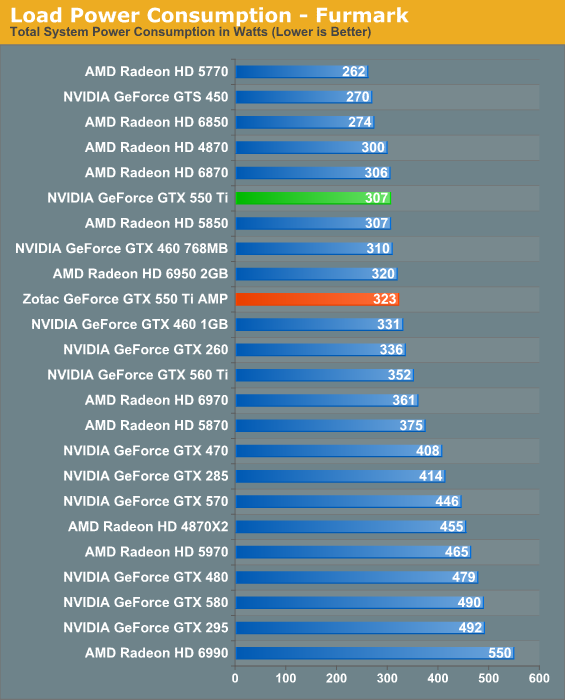
The GTX 550 Ti does not have any kind of overcurrent protection like the rest of the GTX 500 series, so here we can get straight numbers without forcibly disabling it. The results, like with Crysis, are understandably poor for the card; 33W over the 6850, more for the card when it’s running at factory clocks. If a more reference style GTX 550 Ti is anything like this, it bodes poorly for the card compared to the already faster 6850.
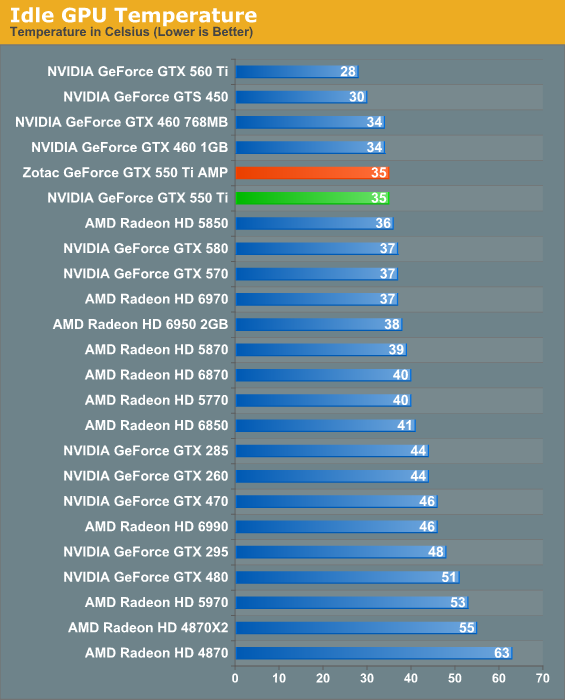
The king of our idle temperature charts is composed of NVIDIA reference cards, and while the Zotac GTX 550 AMP gives a decent performance, it can’t keep up. 35C at idle is still quite good, but we saw better on the GTS 450, and would likely see something similar on a reference GTX 550 Ti.
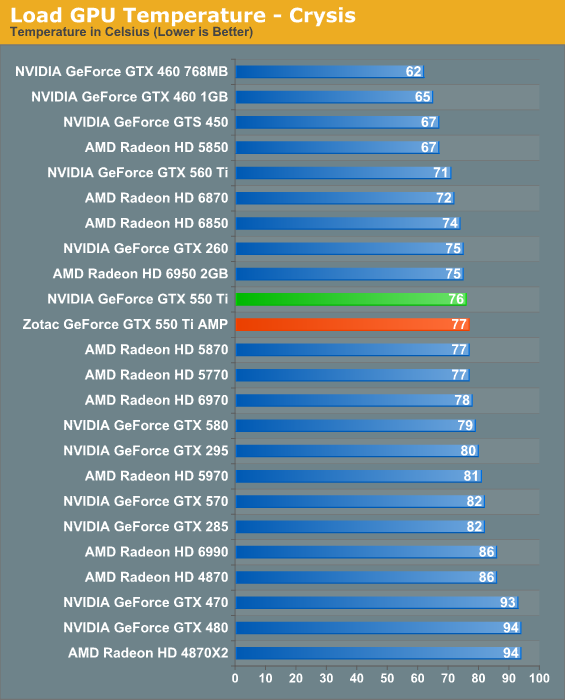
Under load, temperatures end up being middle the road, thanks once more to the card’s higher power consumption. Funny enough it does beat the 5770 by 1C even after all of this, but one could just as well slap the GTX 460 cooler on here and get results that would undoubtedly be below 70C.
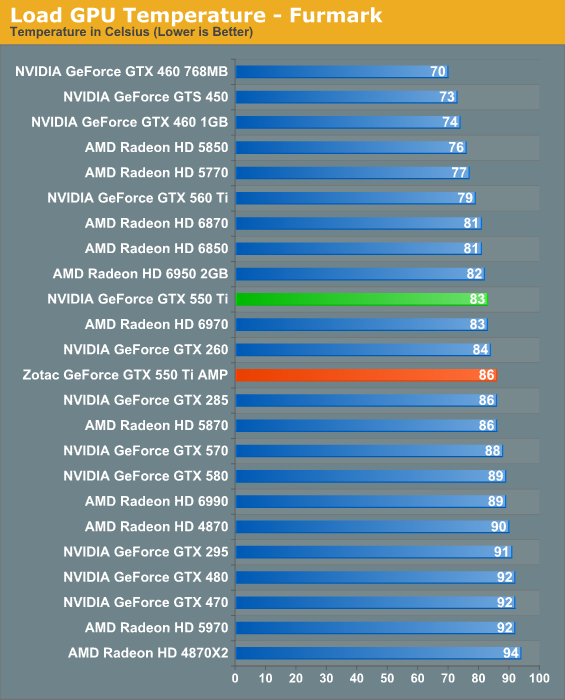
FurMark of course adds several C more to our temperatures. In fact for a lower power card like the Zotac GTX 550 AMP we’re actually caught a bit off-guard. 86C at factory clocks means there’s some thermal headroom to play with for overclocking, but not too much – the GTX 550 Ti’s max temperature is only 95C.
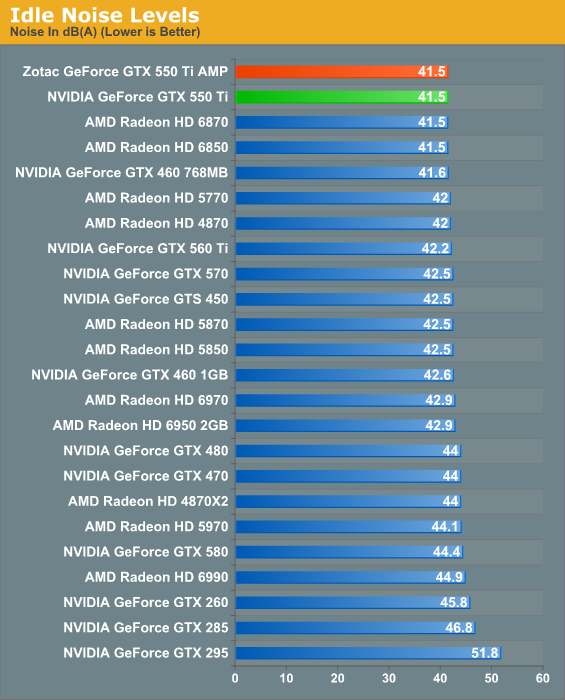
For cards in this performance category, idle noise is pretty consistent thanks to the common use of open coolers. The Zotac GTX 550 AMP doesn’t disappoint here, offering a practically silent 41.5dbA as measured by our meter.
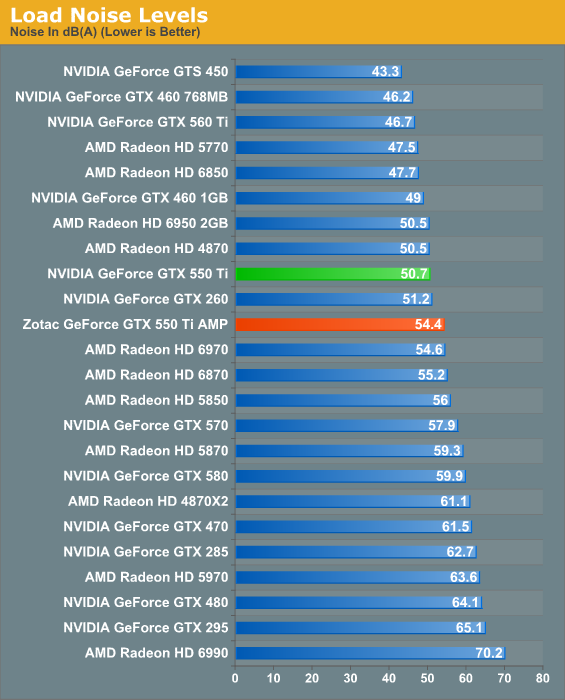
If you were hoping that higher temperatures would be a precursor to lower fan noise, you’re going to come up empty handed here. 50.7 is by no means loud among all the cards we’ve tested, but we’ve seen better. In fact the 5770/6850 both do better, as does the GTX 460 and GTX 560. At the AMP’s full factory overclock we get up to 54.4dbA, which is certainly going to be noticeable. Unfortunately the card doesn’t have the performance even with the overclock to justify the noise.
Ultimately this is less a discussion of the GTX 550 Ti reference design, and more a discussion on the Zotac GTX 550 Ti AMP’s design, which more likely than not takes a hit in cooling and temperatures thanks to the 2nd DVI port partially blocking the card’s external exhaust. But for the time being, it’s what we have to work with.










79 Comments
View All Comments
Soldier1969 - Wednesday, March 16, 2011 - link
Poor mans card, come back when you get at least a 580 or better...valenti - Thursday, March 17, 2011 - link
Ryan, can you explain where the nodes per day numbers come from?I spend a fair amount of time hanging around folding sites, I can't think of anybody else that uses the nodes per day metric. Most people use PPD (points per day), easily gathered from a F@H statistics program such as HFM.net
I'm unsure how to convert nodes/day to PPD, if that is possible. In actual practice, I find that a 450 card nets almost 10,000PPD, while a 460 gets about 12,000. I prefer the 450, after taking into effect price and power needs.
You might want to search on "capturing a WU" to read about how to copy a protein's work files, allowing you to run the same protein for each card.
suddenone - Thursday, March 17, 2011 - link
How good this card is depends on what monitor you plan on using. Anyone that has a small monitor and plans to keep it for at least three years might be happy with this card. I am puzzled to see fps over 60 on a standard 60hz monitor. My gtx 460 ran fine until I upgraded to a 24 inch 1080p monitor. I sold the card on ebay and bought the gtx 570( big gun). The gtx 570 can run any of my games at over 30fps min with all effects at maximum. Peace out.ol1bit - Thursday, March 17, 2011 - link
I bought 2 460's 6 months ago it so. For 149 each, and they beat the 550 in every catigory.This is a bad launch by Nivida. Old product is faster at same price or lower.
meatfestival - Monday, March 21, 2011 - link
Not sure if it's already been posted, but although it does indeed use id Tech 4, Raven wrote a custom DX9 renderer for it.The multiplayer component (based on the Quake Wars fork of id Tech 4) is on the old OpenGL renderer.
ClagMaster - Friday, March 25, 2011 - link
The GF116 has much optimized and improved performance over that of the GT-450 it is destined to replace.However, the GTX-550 Ti is a low-end replacement for the GT-450 and is priced to much. I wished nVidia called it the GT-550 and reserved the Ti designation for something truly high performance.
For $20 more, I can get a ATI-6850 that gives me 25% more performance for 10% less power consumption.
chrcoluk - Friday, October 21, 2011 - link
I think people are been very harsh on the card.its slower than the older 460 on these benchmarks but the gap isnt a gulf and in addition peopel are completely discounting the power factor. The major problem with graphics cards today is they use too much power, intel have managed to reduce power load whilst increasing performance, yet nvidia cant do the same.
Also no considerations taken on what people are upgrading from, I currently have an 8800GT and am only considering upgrading, a 550 TI would double performance whilst using a little more power on load over the 8800GT and only a 3rd on idle. Buying a 460 would give me a bigger performance boost but I need to connect a 2nd power cable (wtf???) and it uses significantly more power than the 550, about 50% more. so for watts vs performance the 550 beats the 460. But it seems people on here and most other sites consider power consumption as 0 importance, maybe they dont pay their own power bills?
The 550 TI will have many sales because nvidia know most people dont upgrade every year but more likely 3+ years frequency so the 550TI doesnt have to beat the 460 it just has to be significantly better than DX9 and DX8 cards at a good price point whilst also not needing someone to maybe buy a fatter psu as well (not considered here when comparing prices). The 550TI will double my current performance, and I guess the 460 1 gig would be about an extra 20% or so on top of that. Amount of video ram is also important, texture heavy games will saturate 768meg so in those scenarios the 550 is a better choice than the 768 460 model.
xKerberos - Tuesday, January 17, 2012 - link
Oh finally someone who makes some sense! In my country, GTX460s are more expensive than GTX550 Tis and my overclocked Gigabyte 9800gt was struggling to run Battlefield 3 so I picked up an MSI GTX550 Ti with 1gb of ram and factory overclocked. It runs BF3 like a dream at high. And seeing how it munches on VRAM, I'm surprised how people with 768mb cards run that game.Granted I have a tiny 1280x1024 Dell UltraSharp 19" monitor so I don't need a high end card to max games out. My 9800gt was doing a fine job until BF3 came out. I also had to fork out for 8gb of ddr2 ram to run that beast properly.
Anyway what I like about my new card is it was cheap (half the price of GTX560, although at half the performance), it runs very cool (36C on idle in a warm tropical country! max 60C on load), very quiet and it does the job. I won't have to upgrade for a while yet!
UpStateMike - Wednesday, February 22, 2012 - link
I have to agree with this. About a month ago I began the project build to replace an ancient dinosaur that was maxed out and tired.I kept my good 630W ps, a 24" led 1080p viewsonic monitor, and a 9800 gtx card that I figured I could use in the new build.
I started with a new case - rosewill challenger, and build around an i5 Sandy Bridge 2500k put into asus p8z68-vpro mb. I have 8gb of gskill ddr3 1333 at the moment.
Now that this is all up and running, instead of my old system being the performance bottleneck of the video card, the card is now the bottleneck.
I began by trying to cheap out and stay at $80 range, and OC the cards mentioned here, but I liked the lower power use (I'm a medium gamer but I wanted a PC that could handle any game I want to get in the future) of the 550ti and although I'm at $120 for this card, my guess is when I go for my next upgrade phase in about 6 months or so, I can wait for a good deal to come along and get another one to SLI and another 8gb of memory.
So for me, this is a big upgrade that I can build on to SLI and get to where I should be happy for the next couple of years. I do more photography editing and whatnot so this greatly helps me with that and I can still game as I get some time. I can appreciate that the differences are minor for anyone that has bought a card in the last year, but coming from a 9800gtx I'm very happy.